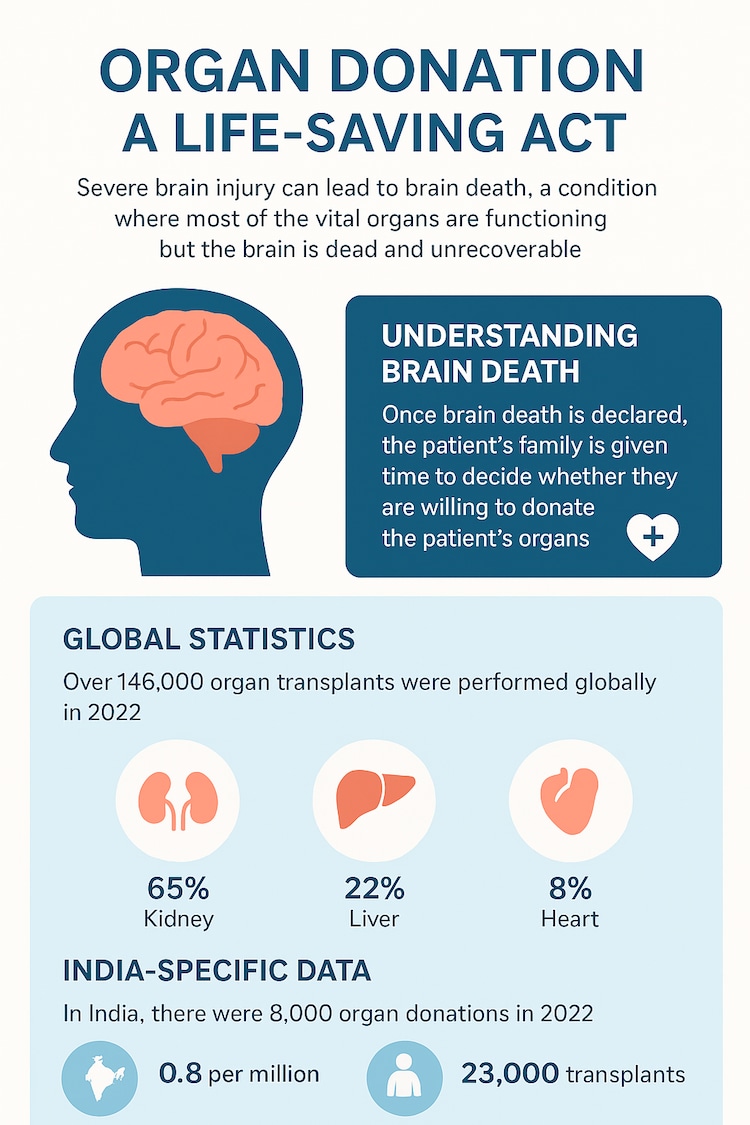One organ donor can save the lives of 8 people, yet 5 lakh people can wait for transplantation
After the death of the brain, organ donation patients need important organs. Despite high registration, India’s actual implants are low, highlighting awareness challenges.

In short
- Ang donation increases life by giving them to organs
- Diagnosis of brain death is done through specific medical examinations by professionals
- Families decide on donation during difficult times after brain death announcement
Anga donation can be considered as pure form of service to mankind and the highest form of development can pass to prolong the life of a species fellow beings.
Severe brain injury refers to brain damage that may result in spreading road traffic accidents, large -scale brain bleeding, hypoxia ischemic encephalopathy, or exceptional injury. During the death of the brain, there is a window of time within which viable vital organs can be cut from a donor’s body, with full consent from their family. The most obtained organs include the heart, lungs, liver, kidneys, pancreas and other parts in the small intestine such as cornea, skin and hands.

Understand brain death
The death of the brain refers to a condition where most of the vital organs are functioning, but the brain is dead and inaccessible. A team of health care professionals conducts tests such as the apnea test, brain stem reflex, and sometimes cerebral angiography to declare brain death.
Once the brain is declared dead, continuous care in the hospital is often considered fruitless. However, before the ventilator support is withdrawn, the patient’s family is given some time to decide whether they are ready to donate to the patient’s organs. Organ donation is a righteous function because the organs of a patient can fuel life alone in more than seven people. Unfortunately, the decision to donate falls on family members during the most dark and lowest phase of his life, when they are struggling with the loss of a loved one.
In Karnataka, organ allocation is performed by a government body named Jeeva Sarathkathe, which oversees the allocation of organs to the recipients after obtaining consent from the patient’s family. Unfortunately, in India, despite receiving more than 2 lakh registrations annually for organ donation, only 18,000 organ transplants occur actually each year.
Given the huge difference in a person’s life, it is important for every Indian to recognize the importance of this selfless work and to participate in spreading awareness. Being a donor, one can overcome religious, political and economic boundaries and can be true saying: “A body, many lives”.
WHO / Global Observatory on Donation and Transplantation (Godt)
GODT compiles global, regional and country-level data on organ donation and transplant in its most recent summary (2022-2023 data):
- In 2022, more than 146,000 solid organs were transplanted globally – an increase of 8.7% compared to 2021, yet only a fraction of the global requirement.
- Kidney implants form majority (~ 65%), followed by liver (~ 22%), heart (~ 8%), and lungs (~ 4%).
- Live donor transplants ~ 39% represent renal transplant and ~ 20% worldwide liver transplant.
- Donation rates vary widely: Spain, America and some European Union countries report per million population (PMP) on 40 deceased donors, while many countries in Asia and Africa report <5 PMPs.
(Source: Who and God)
Dr. Lohit Shetty Raju, Input by Advisor – HPB and Liver Transplant Surgery, Manipal Hospital, Bangalore





